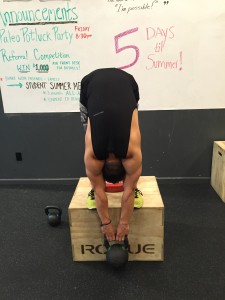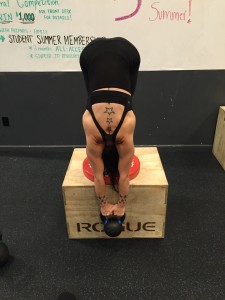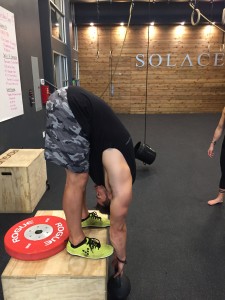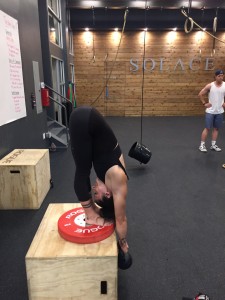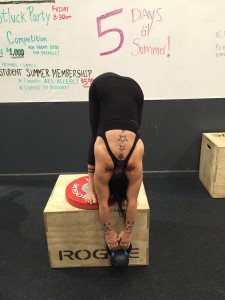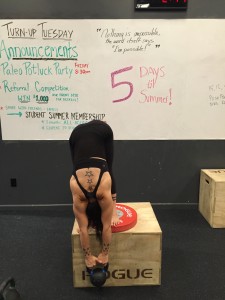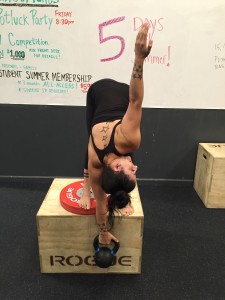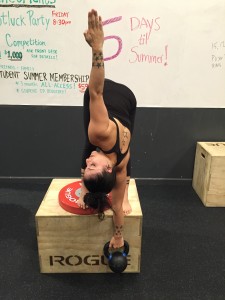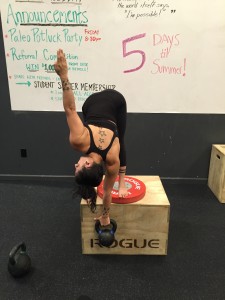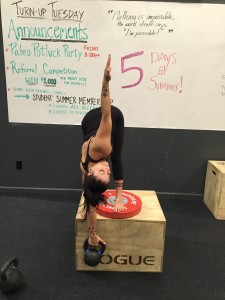I spent the weekend taking the CrossFit Advanced Kettlebell Seminar with Jeff Martone. The content was divided between what I call “Old School” and “New School.” The Old School stuff was rotational work with the kettlebells most notably the Windmill and the Bent Press, two lifts that are synonymous with physical culture. Look at this iconic photo of Arthur Saxon. How cool is that? 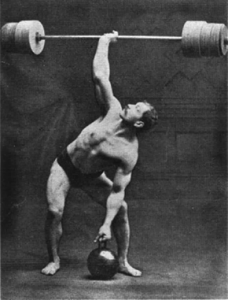
The new school content was what is known as Girevoy Sport or Kettlebell Sport. In this sport like Olympic Weightlifting there are 3 contested lifts: the snatch, the clean, and the jerk. However, unlike Olympic Weightlifting, this is an endurance sport where athletes compete to complete as many reps as possible (usually in 10 minutes) of either snatch, clean & jerk (“long cycle”) or jerk (“short cycle”). They basically stand in one place and lift the kettlebell(s) as many times as they can without putting it down. When competing with a single bell, they are only allowed one hand switch. The bells can not be put down. Merely standing and holding one or two kettlebells for 10 minutes without putting them down can be arduous. Imagine exercising non stop for that time.
Personally I was excited to work on Windmills and the Bent Press was a move I have struggled with and was eager to get some pro tips on how to do it correctly. I have had some exposure to Girevoy Sport through friends but never really had any desire to do it. However, I was fascinated by the fact that my female friends could do 100 kettlebell snatches on each arm without putting the bell down. My best was around 27. So clearly there was something to be learned about efficiency.
I prefer the kettlebell moves where I do 3 to 5 reps per side and put the bell down. When we got to the KB Sport section of the course I was less enthusiastic to be doing longer sets of cleans, jerks and snatches. However, Jeff was able to layer on so many effective techniques to help relax. The goal as he described it was not a powerful effort but effortless power. With each passing set he cued different ways to stand without tension, to relax whatever body part wasn’t working like your face or the opposite ar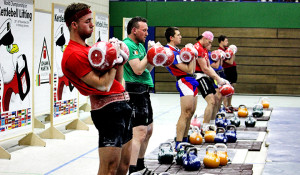 m. He emphasized “anatomical breathing’–breath coinciding with the position of the body. Constantly breathing and not holding the breath. He emphasized a relaxed grip and different ways to minimize the stress on the grip.
m. He emphasized “anatomical breathing’–breath coinciding with the position of the body. Constantly breathing and not holding the breath. He emphasized a relaxed grip and different ways to minimize the stress on the grip.
By the end of the weekend we tested out with a set of 30 snatches on each arm with a 20kg kettlebell. It was the easiest 60 kettlebell snatches of my life. I was shocked at how little I was winded after the effort. My grip was taxed but I never felt like I had to drop the bell nor was I afraid it would fly out of my hand if I dared to do another rep. I was a little surprised because, if you have ever spent two straight days swinging kettlebells, then you know your hands are just rubbed raw and your hamstrings are smoked, I thought for sure I was going to struggle to get to 30 reps. I didn’t. It was effortless power.
It made me start to wonder if I could use these techniques to do 60-100 reps of any exercise. Martone claims that the Russians use that 100 rep milestone for squats and deadlifts and lots of other exercises. Certainly being more efficient and more relaxed and breathing more would have to carry over.
I’m lucky if I breathe once per rep. We learned that on just the swing itself you take two breath cycles. Additionally, when you receive the bell there is an exhale, when you lower the bell there is an inhale. If you rest with the bell in the rack or overhead, you continuously puff out short exhales. Ultimately, there is way more breathing going on in one rep of a kettlebell snatch than I had previously imagined. This breathing helps a lot in being able to sustain longer efforts. I think about what I do in a set of wallballs or burpees and realize I am not breathing nearly as frequently as I could… or should.
Further exploration is required.

